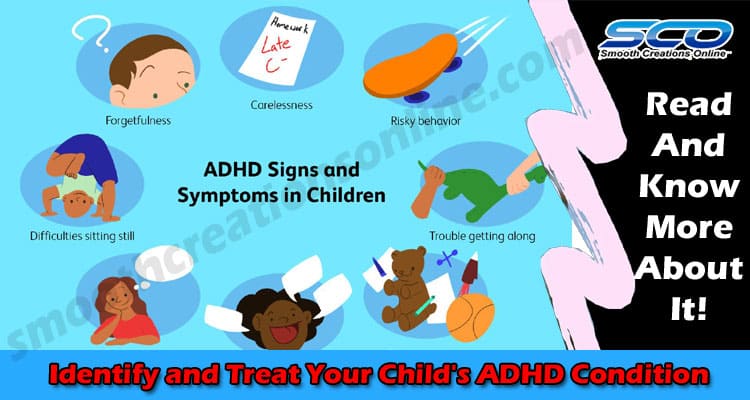Identify and Treat Your Child’s ADHD Condition: Short attention spans and high activity levels aren’t always indicative of Attention deficit hyperactivity disorder or ADHD; there are various reasons children are hyperactive or have difficulty concentrating. On the other hand, some children have a harder time sitting still and paying attention than others, which causes them to face challenges in their everyday lives.
However, if your child can’t seem to stay focused long enough to complete work, you should be aware of the potential of ADHD and treatment for ADHD.
Table of Contents
Signs and Symptoms:
Kids, like adults, may suffer from one of three kinds of ADHD:
- Predominantly inattentive appearance: Children with ADHD have difficulty focusing and staying on task. They may seem to be frequently daydreaming, and they may find it difficult to concentrate.
- Combined presentation: The mixed or combined presentation produces concentration and hyperactivity problems.
- Hyperactive/impulsive appearance: Children with this appearance are impulsive and have trouble sitting still. They wiggle and shift in their seats all the time and appear to have boundless energy.
An inattentive youngster, for example, may have difficulty understanding homework tasks since they were not paying attention in school. Alternatively, a hyperactive child may struggle to retain friendships since their impulsive behavior irritates their classmates. Symptoms must impact a child’s daily life in some way to fit the threshold for an ADHD diagnosis.
Attention Deficit Hyperactivity Disorder (ADHD) Diagnosis:
It’s critical to get your kid evaluated if you or your kid’s teacher feels they have ADHD. Early diagnosis may help prevent the development of additional problems and secondary illnesses like oppositional defiant behavior or anxiety.
There isn’t a specific laboratory test for diagnosing ADHD. Instead, a pediatrician or mental health practitioner can assess a child’s symptoms to see if they meet the criteria. Several ways are frequently used to acquire data about a child’s behavior, including:
- The clinician will study more about your kid’s growth and family history through parent and child discussions.
- In the home, parent report forms evaluate a child’s behavior. A mental health expert may question a child’s capacity to follow instructions, play quietly, or wait their turn in a dialogue.
- Teachers fill up teacher report forms with information regarding a child’s behavior and ability to focus in the classroom. Teacher reports can help determine how difficult it is for a child to stay on task and seated compared to their peers. Because some youngsters with ADHD struggle to retain friendships, feedback regarding a child’s social interactions can be beneficial.
Treatment Options for ADHD in Children:
Parents are often hesitant to talk about their worries regarding treatment for ADHD because they are afraid their children may be put on drugs with dangerous side effects.
Broadly classified, there are two types of treatment:
- Neurofeedback therapy: This therapy has been shown to immensely help those with ADHD. Neurofeedback is a type of biofeedback in which video or audio cues are utilized to assist the mind in learning to produce the desired brain wave patterns. It is non-invasive and doesn’t have any of the many adverse effects that other procedures, such as the use of drugs to treat ADHD symptoms, have.
- Non-medication treatment: Another effective non-medication treatment is parental education. This treatment entails professionals supporting the caregivers in learning various behavioral therapy methods and discipline approaches to help lessen ADHD-related behavior problems.
Parenting Techniques:
It’s challenging to raise a child with ADHD. Youngsters with ADHD are more likely to be excluded from childcare and school, and they are more prone to act out at home. It can also be challenging to encourage children to complete their assignments and follow directions.
They demand more framework and more monitoring than other children. Here are a few tactics for behavior adjustment that are frequently discussed in parent training programs:
- Provide clear instructions: Before giving directions, make sure you have your kid’s complete attention. And, to be sure your child understands, have them repeat what they heard back to you. For example, “Please make your bed,” you say after turning off the television, making eye contact, and placing a hand on your kid’s shoulder.
- Appreciate your child’s attempt: Observe your child’s good behavior and praise them. Children with ADHD are motivated to behave by praise, and constant feedback is essential.
- Pay attention to the positive: Positive playtime minimizes the need for attention. It will also improve the effectiveness of your actions.
Living With ADHD:
While there is no specific treatment for ADHD, the signs can usually be treated well. It’s natural for your child’s conditions to alter as they grow older. However, because your kid’s treatment will almost certainly need to be changed over time, it’s critical to keep track of their issues and progress.
While raising kids with ADHD comes with its own set of problems, with the proper support and therapies, children with ADHD can excel. Additionally, if the symptoms are treated in the early stage, there are fewer chances of aggravation.
Also Read – How To Make A Promotional Video For Your Company?


